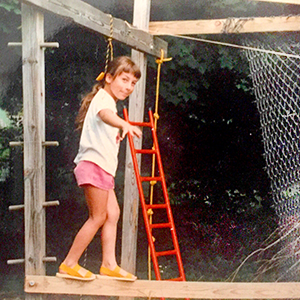My second grade teacher, Pat Quenzel, was a master of wonder. In her class, we spent hours looking closely at the world around us, engaging from a place of curiosity. We sketched worms and improvised plays and designed new systems of government. We learned how to ask questions and then how to ask more questions. Pat skillfully refrained from handing us the answers, leaving us to guess and imagine and hypothesize and test and stay in a place of not-knowing.
 At some point during my second grade year, my family planned a vacation to a campground in rural Nova Scotia. My mother spoke with Pat on the phone and excitedly told her about what my parents had planned for my brother and me: “We’re bringing the bird book and the plant book and the insect book…” A few minutes later, Pat called my mother back with a request, and made a statement that stayed with my mother forever: “This trip sounds wonderful, but please don’t bring all those books. Just have them LOOK at the birds, and the plants, and the insects. Let them look at a flower and see what it reminds them of. Let them make connections to what they know. If you bring the books, you are just naming these things. And if you name it, they think they know it.”
At some point during my second grade year, my family planned a vacation to a campground in rural Nova Scotia. My mother spoke with Pat on the phone and excitedly told her about what my parents had planned for my brother and me: “We’re bringing the bird book and the plant book and the insect book…” A few minutes later, Pat called my mother back with a request, and made a statement that stayed with my mother forever: “This trip sounds wonderful, but please don’t bring all those books. Just have them LOOK at the birds, and the plants, and the insects. Let them look at a flower and see what it reminds them of. Let them make connections to what they know. If you bring the books, you are just naming these things. And if you name it, they think they know it.”
There’s something profound about Pat’s words, especially in our present moment, when we carry the world’s information around on tiny high-powered computers in our pockets. As members of the arts collective Royal Frog Ballet stated in a recent panel discussion, shifts in technology, while empowering and connecting us in many ways, also lead us to engage in the constant “short-circuiting of wonder.” As my second grade teacher explained all those years ago, there is a substantive difference between having information about something and knowing it.
This is one of the reasons why Gold Standard PBL feels so essential and why we need to cultivate a form of PBL that leaves space for inquiry and curiosity. Several components of Gold Standard PBL are critical if we want to move beyond “naming” to a deeper form of “knowing.”
Powerful entry events
A strong entry event does more than introduce the project task. It engages students and sparks wonder. Consider sharing a compelling primary source image without context, having students engage in a simulation or hands-on activity, or posting a statement that might seem paradoxical or contradictory. The See-Think-Wonder Visible Thinking routine is one way to support deep and inquiry-based student exploration of a stimulus. You can view this routine being used to launch a project in the Water Quality Project.
Open-ended driving questions
In classrooms where high-quality PBL is happening, students wrestle with driving questions that are not “Google-able.” These initial questions lead to more questions, and these questions invite students into an active process of uncovering new concepts, skills, knowledge, and ambiguity. For example, in the “A Civilized World” project, students explore the question “Where is the line between ‘primitive society’ and ‘civilization’?” This question invites students into deeply engaged learning about historical framing, cultural biases, ancient societies, and the limitations of simple labels.
Intentional, well-sequenced scaffolding that incorporates direct experience:
The bird book/plant book/insect book /internet are used strategically and appropriately as scaffolding at key moments, but they never supplant direct experience or exploration. For example, students might draw conclusions about thermodynamics through designing and testing their own cooking devices and experimenting with different forms and materials, rather than reading a textbook first and then following a “recipe” to build a solar cooker. Students can learn about the history of their communities by conducting interviews with multiple community elders who lived those histories first hand, starting with questions and stories instead of a single crystallized narrative. The deliberate sequencing and scaffolding of these projects leaves space for “productive struggle” and student-driven learning.
In the most powerful PBL classrooms, students are intimately familiar with wonder, and recognize the difference between naming something and knowing it. Sitting with uncertainty and making meaning through direct experience is frustrating and uncomfortable and messy. It’s also beautiful, and necessary, and vital. Many of the local and global challenges we face today are rooted in a preemptive sense of certainty—about ourselves, about one another, and about the world. In order to move through these challenges we need to relearn how to work from a place of authentic curiosity.
